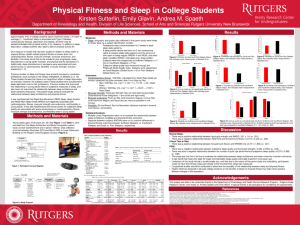Sutterlin, Kirsten: Physical Fitness and Sleep in College Students
Title: Physical Fitness and Sleep in College Students
Name: Kirsten Sutterlin
Major: Exercise Science
School affiliation: School of Arts and Sciences
Programs: Aresty – Research or Conference Funding Recipient, Honors Research Program for Exercise Science
Other contributors: Andrea Spaeth and Emily Glavin
Abstract:
Physical Fitness and Sleep in College Students
Background: College students are highly susceptible to both sleep deprivation and a lack of physical activity. Sleep and physical fitness have a bidirectional relationship; however, it is not well understood and has not been studied in depth for the average young-adult population. The present study aimed to determine the relationships between sleep architecture (profiler and actigraphy measured sleep) and health related physical fitness, and between subjective sleep quality and health-related physical fitness in young adults (18-26y).
Methods: N=19 participants were recruited from a parent study that measured sleep. A wrist-worn Actiwatch measured total sleep time and sleep profiler measured total sleep time, time of sleep/wake onset, and the amount of time spent in each stage of sleep (Non-Rapid Eye Movement 1-4, and Rapid Eye Movement). Subjective sleep quality was assessed through the Pittsburgh Sleep Quality Index, the Epworth Sleepiness Scale, and sleep diaries. For the physical fitness assessment, participants completed a step-up test, hand-grip strength test, three muscular endurance tests (push-ups, curl-ups and squats), and a sit and reach test. Descriptive statistics were conducted and linear regressions were run to assess the relationship between sleep variables and fitness outcomes. AVOVAs were then used to compare means between sufficient sleepers (≥ 7h) and insufficient sleepers (≤ 7h).
Results: Participants who reported getting 7 or more hours of sleep per night performed better on the push-up assessment than those getting less than 7 hours of sleep. Normal sleep Wake After Sleep Onset was positively related to hand-grip strength, and REM time was negatively related to flexibility. For the 9-hour time in bed condition, NREM2 time was positively related to flexibility. Subjective sleep quality was negatively associated with both hand-grip strength and the number of push-ups performed.
Conclusion: In the future, longitudinal studies should be conducted to determine the causality of the relationship between physical fitness and sleep. Additionally, educating college students of the ways in which physical fitness and sleep interact with each other may induce positive lifestyle changes in this population.
